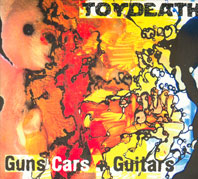: toydeath
Self release, 2005
www.toydeath.com
 Toydeath seems a bit of a misnomer for this Sydney band. Though the group has always based their work on “circuit bending”–gutting [and rewiring] whatever toys they could get their hands on–their skill is not in the carnage they reek but rather their ability to stitch the twitching remains back together to roam again like Frankenstein’s monster. Paradoxically, after a tune-up and voice box change courtesy of Toydeath, the toys are more alive than ever.
Toydeath seems a bit of a misnomer for this Sydney band. Though the group has always based their work on “circuit bending”–gutting [and rewiring] whatever toys they could get their hands on–their skill is not in the carnage they reek but rather their ability to stitch the twitching remains back together to roam again like Frankenstein’s monster. Paradoxically, after a tune-up and voice box change courtesy of Toydeath, the toys are more alive than ever.
But just as Frankenstein’s monster came to question his place in the world, the band now seems to want something more and so we come to the major development on the group’s latest album Guns, Cars & Guitars–the appearance of actual songs. This is the focus of the first half of the album, both actual songs complete with lyrics and large slabs of songs taken from toys. Whether this is good news or not depends on your point of view. It certainly makes the band’s work more accessible and even 'sensical.' However, it also detracts from Toydeath's previous strengths as it relegates the sounds of screaming and malfunctioning toys to support the songs, rather than allowing the toys to sing for themselves.
I have seen Toydeath performances where they use the toys to great effect, both sonically and to produce a sort of storyline, the performance personas such as GI Joe and L’Booby relegating those behind the masks to mere players in a pantomime along with the other toys. However, this is largely lost in the band’s recorded output as their use of toys translates only as a refusal of electronic music’s current favoring of sonic purity and reverie. This alone remains refreshing, if definitely not new and places the group in a crowd of preset pushers and plunder artists. Perhaps Toydeath's is an art based in performance and such critique is unfair but without the visual reference of the toys themselves and the players' interaction with them it is hard to sustain attention.
Curiously the most interesting moments are towards the end as the songs begin to disappear and the tracks get shorter, slipping into one another–confusion grows and you begin to feel lost in some sort of absurd maze of lo-fi sound. There are certainly moments when the toys shine, most notably when allowed to speak for themselves, producing a low bit rate chorus of confusing half sentences and repeated questions, or better yet when urged to converse with others such as on the track Oh Barbie. Unfortunately though, Guns Cars and Guitars seems to see Toydeath in a bit of an identity crisis, unsure whether they or the toys are on show.
Ben Byrne






